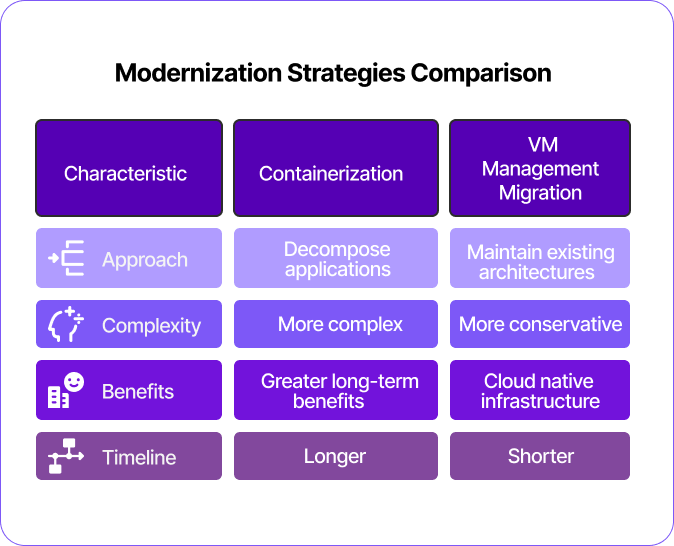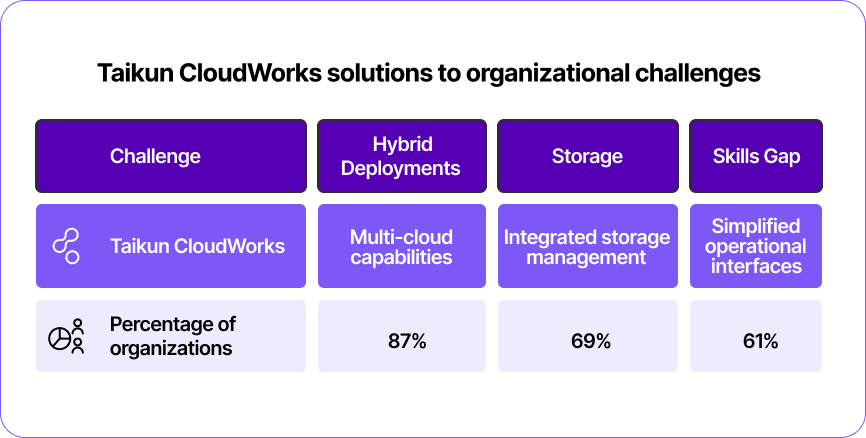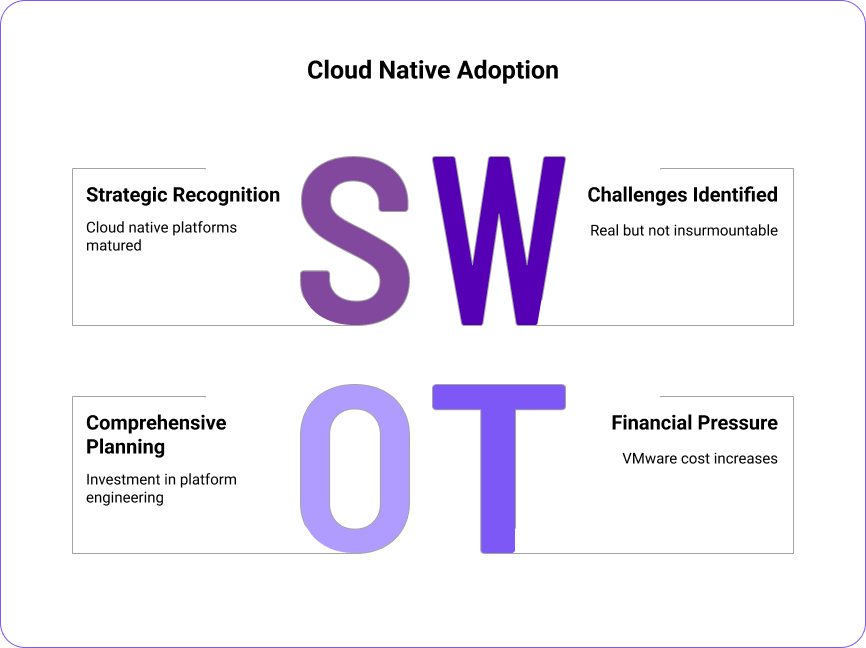
VMware Alternatives 2025: Why 95% of Enterprises Are Migrating to Kubernetes
The enterprise technology landscape is experiencing a seismic shift. According to the Voice of Kubernetes Experts Report 2025 by Portworx by Pure Storage, a staggering 95% of enterprises are actively planning to reduce their VMware footprint, with 33% looking to eliminate VMware entirely. This comprehensive survey of 523 qualified IT professionals reveals not just the scale of the VMware exodus, but the strategic direction enterprises are taking as they modernize their infrastructure.

The implications extend far beyond cost considerations. Organizations are fundamentally rethinking their approach to application deployment and infrastructure management. As enterprises grapple with rising VMware costs following the Broadcom acquisition, they're discovering that the migration to cloud native platforms offers not just financial relief, but enhanced operational capabilities that align with modern DevOps practices.
The Financial Reality Driving Change
The catalyst for this massive infrastructure shift is undeniably financial. The Broadcom acquisition of VMware has created unprecedented cost pressures forcing even loyal customers to reconsider their virtualization strategy. The survey data reveals a stark reality: 44% of organizations that received updated Enterprise License Agreements (ELAs) from VMware experienced cost increases exceeding $1million, with 13% seeing increases of more than $10million.
These aren't marginal price adjustments—they represent fundamental changes to enterprise virtualization economics. One survey respondent captured the sentiment: "It's a 35% cost increase for us, which is causing us to move away after 20 years of being a VMware-only shop." Another expressed their frustration more directly: "We are moving off VMware. SO SAD what Broadcom Inc is doing."
The cost pressure, identified by 66% of respondents as the primary driver for seeking alternatives, is compounded by modernization initiatives, cited by 58% of organizations. This convergence creates a perfect storm accelerating cloud native adoption.
Cloud Native: From Experiment to Enterprise Standard
The transformation of cloud native platforms from experimental technologies to enterprise-grade infrastructure represents one of the most significant shifts in modern IT. Currently, 41% of organizations report that all or most applications run on cloud native platforms, but the future trajectory is compelling: 82% plan to build most new applications on cloud native platforms over the next five years.
Perhaps most significantly, enterprises are trusting their most critical applications to cloud native environments. The survey reveals that 58% of organizations are building Tier 0 or Tier 1 applications—mission-critical systems with strict requirements for performance, uptime, and data protection—in cloud native environments. An additional 80% build important applications with more relaxed requirements on these platforms.
This broad adoption demonstrates that cloud native technologies have achieved the reliability and operational maturity required for enterprise production environments. The progression from experimental to mission-critical adoption reflects the maturation of cloud native technologies and operational practices.
Hybrid Cloud Dominance
Enterprise preference for hybrid cloud deployments reflects the complex reality of modern IT environments. According to the survey, 87% of enterprises have chosen hybrid cloud as their deployment model for cloud native infrastructure. This overwhelming preference challenges the narrative that enterprises are simply moving everything to public cloud providers.
Instead, organizations are making nuanced decisions about workload placement based on specific requirements. The survey shows 43% deploy most cloud native workloads in public cloud while maintaining some on-premises infrastructure, while 26% maintain an even split. This diversity suggests there's no one-size-fits-all approach to hybrid cloud architecture.
The success of hybrid strategies depends heavily on platforms that abstract underlying infrastructure differences. Kubernetes has emerged as the standard for this abstraction, providing consistent application deployment and management capabilities across different cloud environments.
Data-Intensive Workloads Lead The Way
The migration of data-intensive workloads to cloud native platforms represents perhaps the most significant indicator of enterprise confidence in these technologies. The survey reveals that 98% of organizations now run data-intensive use cases in cloud native environments.
The breakdown shows databases leading adoption at 69%, followed by real-time analytics at 67%, and AI/ML applications at 60%. This distribution demonstrates that organizations aren't selectively choosing simple workloads—they're migrating complex, performance-critical applications that form the backbone of digital operations.
The success of data-intensive workloads in cloud native environments depends heavily on storage and data management capabilities. Organizations require storage systems that provide persistent data access across container restarts, automatic backup and recovery, and performance optimization for different workload types.
Migration Strategies: Multiple Paths Forward
Organizations are implementing sophisticated strategies that balance immediate cost relief with long-term modernization objectives. The survey shows 59% plan to modernize existing VM workloads by re-architecting them as containers, while 57% intend to migrate VM management to Kubernetes using technologies like KubeVirt and Red Hat OpenShift Virtualization.
The containerization approach requires decomposing monolithic applications and implementing cloud native design patterns. While more complex, this strategy offers the greatest long-term benefits in operational efficiency and scalability.
The alternative approach of migrating VM management to Kubernetes represents a more conservative strategy maintaining existing application architectures while gaining cloud native infrastructure benefits. This allows organizations to manage both containers and VMs through a single control plane.
The complexity of these strategies is reflected in timeline data. While 83% of organizations anticipated completing VMware workload changes by 2027 in last year's survey, only 67% now expect completion by 2027—a 16-point drop revealing practical migration challenges.

Kubernetes Virtualization: Bridging Two Worlds
The emergence of Kubernetes as a platform for managing virtual machines represents significant evolution in enterprise infrastructure strategy. The survey reveals that 85% of organizations are managing or planning to manage VMs on Kubernetes.
Red Hat OpenShift Virtualization leads the market, chosen by 58% of organizations implementing this approach, followed by SUSE Virtualization (Harvester) at 24%. However, adoption faces challenges, with skills gaps cited by 61% of organizations as the primary obstacle.
Traditional infrastructure teams, who typically assume responsibility for VM management on Kubernetes (60% of organizations), must develop expertise in container orchestration and cloud native operations. Storage integration presents another challenge, cited by 35% of organizations.

Storage: The Critical Challenge
Storage emerges as the biggest challenge for organizations running VMs on Kubernetes, cited by 69% of respondents. The survey shows 85% of organizations want to replicate existing VM storage architectures—including vSAN (58%), VMFS data stores (43%), and vVols (23%)—in Kubernetes environments.
Meeting this need requires solutions that can emulate vSAN's software-defined storage aggregation, VMFS's shared block storage, and vVols' array-based capabilities. These architectures give traditional teams the control they need over application performance, replication, and provisioning.
Taikun CloudWorks: Simplifying the Journey
As organizations navigate VMware alternatives and cloud native adoption, comprehensive platform solutions become essential. Taikun CloudWorks addresses many challenges identified in the survey by providing unified platform management for Kubernetes environments across multiple cloud providers and on-premises infrastructure.
The platform's multi-cloud capabilities align with the 87% of organizations choosing hybrid deployments. Taikun CloudWorks provides consistent operational experiences across different cloud providers, enabling organizations to implement hybrid strategies without vendor lock-in.
The storage challenges that 69% of organizations face are addressed through integrated storage management supporting both containerized applications and virtual machine workloads. The platform's simplified operational interfaces help address the skills gap challenge cited by 61% of organizations.

The Path Forward
The findings paint a clear picture of an industry in transition. The combination of financial pressure from VMware cost increases and proven cloud native capabilities is driving fundamental shifts in enterprise infrastructure strategy. Organizations aren't simply seeking VMware alternatives—they're embracing new approaches that offer enhanced capabilities for modern application development.
The 95% of organizations planning to reduce VMware footprint represent strategic recognition that cloud native platforms have matured to support the most critical enterprise applications. The challenges identified—from storage management to skills development—are real but not insurmountable.
Organizations approaching cloud native adoption as comprehensive transformation initiatives, rather than simple technology migrations, are finding success in implementing these platforms while maintaining operational excellence. The key lies in comprehensive planning, investment in platform engineering capabilities, and selection of platforms that support both current requirements and future growth.
The future of enterprise infrastructure is clearly cloud native, and organizations embracing this transition thoughtfully will be best positioned to compete in an increasingly digital business environment.

Download the full Portworx report to access the complete survey findings and detailed methodology.
Learn more about Taikun CloudWorks and how it can simplify your Kubernetes adoption journey at www.taikun.cloud.

